

©2008 by John and Susy Pint --- Photos by J. Pint unless otherwise credited -- Updated September, 2013
Click here for Smartphone-friendly version
After crawling around in viper-infested limestone caves in northern Saudi
Arabia, it was time for a change and we decided to pay a visit to what I
consider the most fascinating lava field in the whole country: Harrat Khaybar,
home of the celebrated Black and White Volcanoes. I must confess we were
partly motivated by hopes of finding a lava tube longer than Al Fahda Cave in
Jordan which held the record for being the longest surveyed lava cave on the
Arabian Peninsula (923.5 meters).
May 15, 2007. This is Field Trip 62 for the SGS Cave Unit, which now consists of
only three members: Mahmoud Al-Shanti, Mohammed Moheisen and me. We are heading
for a spot only 128 kms north of Medina, so we expect to be at the cave before
dark. “I see the route includes 50 kms of bone-jarring, tire-slashing lava
rubble,” I comment. “Yeah,” says Mahmoud. “It’s a piece of cake. I checked it
out on Google Earth.”
As we drive, we program co-ordinates into our GPS’s. After seven hours, we leave
the highway and find ourselves in a vast field of black lava chunks criss-crossed
by tracks running every which way. Our waypoints prove invaluable, though, and
moments before sunset, we pull up next to a monster of a hole 89 meters long
with passages heading off in opposite directions. We slap one another on the
back: “Now, this is a real cave!”
We had hoped to camp inside the cave, but it’s a 13 meter drop to the bottom of
the collapse, reachable via a narrow trail that hugs one wall. Besides, our
three drivers take one look at the big hole and declare that they are camping on
the surface, even though the wind is howling like crazy. Putting up a tent under
these circumstances is a real challenge. During the night the temperature drops
to a comfortable 18 degrees Celsius.
|
Next day we breakfast at the edge of our enormous hole. Off in the distance, 20
kilometers to the northeast, we can see the White Volcano,
Jebel Bayda, gleaming
in the sunlight. We are surprised to see Little Swifts (Apus affinis) darting in and out of the
cave. We’re used to rock doves living in Saudi caves but this is the first time
we see swifts. Do they use echolocation to find their way around in the dark
as do those on the island of Mauritius? We decide to enter the east passage,
surveying our way in.
|
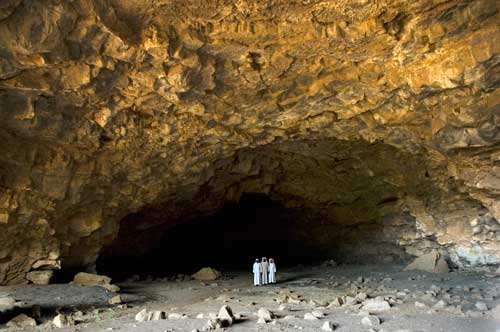 |
The sheer size of this lava tube is staggering. In one place it’s actually forty meters wide. Because the floor is mostly smooth, I get Mohammed to model for me. With the lens open, he walks across the width of the cave, lighting himself up with the flash every few paces.
|
|
Afterwards, Mohammed said he hated modeling for this picture. “Why?” I asked. “Because I had to shoot off that flash right in my eyes twelve times.” “But why didn’t you just close your eyes each time?” “Oooooh,” said Mohammed, “I never thought of that.”
This cave would be impressive for its size alone, but inside we find all sorts of interesting things...
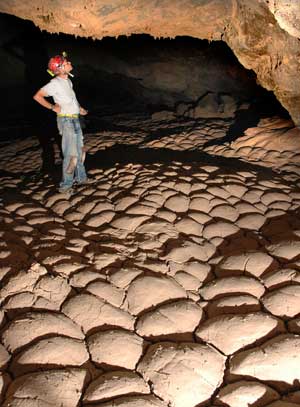
...The floor, for example, is not flat but in most places takes the form of evenly-spaced “domes” of hard mud, about 20 cm in diameter and 6 cms in height. It’s like walking on tightly packed giant ball bearings.... According to an XRD lab report, these mounds contain mainly quartz,albite, kaolinite, nontronite, biotite, microcline and augite. It has been suggested that maybe the nontronite clay causes the swelling.
|
 ...We find wolf and hyena
coprolites all over and plenty of bones. The walls are sometimes decorated with
dazzling white gypsum or brownish calcite formations, including stalactites. In
one place there is a huge block which seems magically suspended from the
ceiling. Our survey covers around 50 meters between each station. Sometimes it’s
farther than the practical range of our Disto laser survey tool. After 948.6 meters,
we reach a second entrance and the end of the passage. We have beaten the
Jordanian record and now have the longest surveyed lava tube on the Arabian
Peninsula!
...We find wolf and hyena
coprolites all over and plenty of bones. The walls are sometimes decorated with
dazzling white gypsum or brownish calcite formations, including stalactites. In
one place there is a huge block which seems magically suspended from the
ceiling. Our survey covers around 50 meters between each station. Sometimes it’s
farther than the practical range of our Disto laser survey tool. After 948.6 meters,
we reach a second entrance and the end of the passage. We have beaten the
Jordanian record and now have the longest surveyed lava tube on the Arabian
Peninsula!
Up on the surface, it’s beastly hot and the wind is still howling. Mohammed
spots our camp in the distance and we walk back over the chunky lava. It was
definitely easier to cover the same distance underground even though the cave
has several curves in it.
After lunch, I go back into the cave to take pictures. When I come out, it’s
just getting dark. “Where are Mahmoud and Mohammed?” I ask the drivers, but they
say they don’t know. By 8:00, we are all getting worried. Suddenly a light pops
up over the edge of the big hole and Mahmoud’s head appears. Both he and
Mohammed are panting and look agitated. “Wolves!” they shout...
| ...They scramble up to the surface and as tea is poured, they tell us their story.
“We decided to survey the other (western) passage,” says Mahmoud. “After 341
meters, it got really dusty and stuffy and smelly. Rocky (the puppy Mahmoud
adopted on our last cave trip) refused to go any further and seemed
paralyzed with fear. There were all kinds of bones in this place and then we
looked into an opening at the very end of the cave. It was full of wolf
droppings, mostly fresh...
|
 |
  After breakfast we all go down into the pit. For the first time, I notice that certain spots on the basalt “stairway” we are using are highly polished. “Mahmoud is right,” I say to myself: an awful lot of people have walked down this path.”
LEFT: Mohammed (arrow) on the narrow trail. RIGHT: basalt surface of the trail, polished by the feet of how many past visitors? |
I look for rock art on the pit walls, but I can’t tell whether the animals I see
are products of my imagination or vestiges of some primitive artist’s
masterpiece.
|
We go into the East passage. I pound an iron rod into the caves dirt floor,
which turns out to be 1.17 meters deep. This sediment has been deposited
sometime during the cave’s three-million-year history. We speculate on what
might lie buried beneath the floor’s surface. No excavations have ever been
done in any of Saudi Arabia’s lava tubes, most of which have floors as thick as this
one.
|
 |
The Workshop
We go around a big bend and approach survey station 5, which is 188 meters
inside the cave. It is almost totally dark except for a faint glow from the
entrance. The hard, smooth mounds cover the floor of the passage, which is
eighteen meters wide...
| ...Mahmoud sits down on a flat-topped rock about 25 cms high
and says, “John, come look at these.” He shows me two “sticks” of basalt which
were lying at the base of the rock he’s sitting on. At first, these look like
nothing else but fragments of rock to me, but I shine my light on the ground and
find another and another and another, all about the same length and thickness.
After we’ve found eight of these, I’m sure they can’t be “just rocks.”...
|
 |
 
On close examination, we see each one has a convex and a concave side and in every case, one end of the “stick” is pointed. When held in your fist, your fingers fall into the concave groove. We look around a little more and find half-moon shaped pieces that fit nicely into your hand and have a very thin edge. These seem to be scraping tools while the others might be for gouging. LEFT: "gouger." Convex side facing viewer. RIGHT: "scraper" has very thin edge and fits nicely in hand. |
Hundreds of chips of
basalt are scattered all over the ground, covered by a thin layer of mud. Only a
few steps away we find two more flat-topped rocks convenient for sitting upon
and each is surrounded by objects of the same shapes we have been looking at.
“This is just like the obsidian workshops I saw in Mexico,” I tell Mahmoud. “All
the pieces we are looking at are the rejects. The good stuff was carried out of
the cave.”
THE WOLF PASSAGE
We walk back to the entrance and find that the drivers have lowered all their
tea-making equipment straight down into the entrance by rope. After tea, we
three cavers—plus Rocky the cave dog—head into the Wolf Passage which I haven’t
seen yet.
|
|
The entrance to this side of the cave is spectacularly big. On top of
the breakdown just inside the entrance we find a baby crow with a
broken wing. Mahmoud immediately adopts the crow, as he did Rocky. This
west passage has a flat floor with no mysterious mounds. It also has
lava levees which the other passage doesn’t. At a certain point, we
come upon lots of bones which look very old and a pile of feathers
which look very recent. “Those feathers weren’t here yesterday,” says
Mahmoud. It’s interesting that the predator brought the bird this far
into the cave, where there’s no light at all. We go a little further
and find a huge Ibex horn. At this point, Rocky the dog lies down on
the floor and refuses to walk. A second later, Mahmoud spots two red
eyes watching us from deeper inside the cave. We decide it’s time to
leave. Mahmoud has his arms full carrying Rocky in one and the crow in
the other. It—whatever—it is, does not follow us.
Near dusk, the swifts return, swooping through the air like bats. Are they
catching insects? We haven’t noticed any flying insects around here at all.
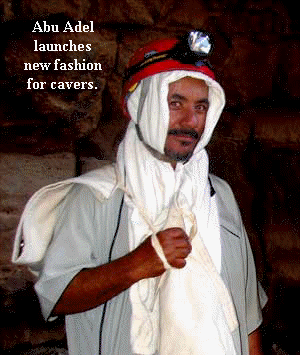 Night falls. Along the edge of the pit we see flickers of fast-moving shapes. At
first we assume it’s the swifts but we find they are large bats (well, larger
than Asellia tridens, which we usually see). The bats fly fast, round and round
along the walls in a wave-like pattern, “cresting” barely one meter above the
lip.
Night falls. Along the edge of the pit we see flickers of fast-moving shapes. At
first we assume it’s the swifts but we find they are large bats (well, larger
than Asellia tridens, which we usually see). The bats fly fast, round and round
along the walls in a wave-like pattern, “cresting” barely one meter above the
lip.
Next morning, we pack up to the shouting and banter of the drivers. Naturally
the wind is howling like crazy, making it just as hard to take down my tent as
it was to put it up. Everyone has cooperated to collect our trash for burning,
but when I go off to answer nature’s call (a long walk is required) I see that
the black lava is now dotted with white spots as far as the eye can see: a sea
of Kleenexes!
After our return to Jeddah, we email pictures of the basalt fragments we found
to everyone we can think of. Replies come in:
“Stone age tools? They’re fakes.”
“Stone age tools? They’re geofacts not artifacts.”
“Stone age tools? Yes, that’s what they are and they’re at least 600,000 years
old.”
Return to Umm Jirsan
Two weeks later we’re on our way back to finish mapping the entire system, which
includes three sections of lava tube and three collapses. This time the only
cavers are Mahmoud and I and he is not in the best of shape, having badly
sprained his back the previous night.
During the drive, we plot the location of our cave on the geological map of
Harrat Khaybar and discover that we can actually see the string of collapses we
have been exploring. Our cave is in one of 40 "Whaleback Flows," which are
slightly elevated areas above lava tubes, always punctuated with a number of big
holes where the ceiling has fallen in...
| ...What’s exciting
is that our survey of the cave confirms that there can be intact lava tubes
between one hole and another. Since some of the Whaleback Flows are up to 17 kms long, it looks like there may
be enough long lava tubes in Harrat Khaybar to satisfy an army of cave
explorers.
|
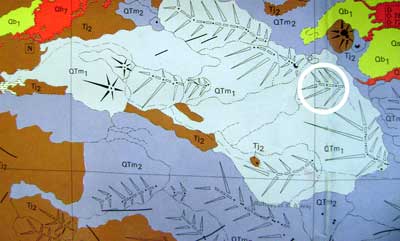 |
“Actually, that is nothing,” says Sa’ad, with a straight face. “Many years ago,
two of my cousins and I were starving. As one of these cousins was rather
chubby, we decided we had no other choice but to eat him. So we sent him off to
gather firewood, but he had no idea what we were planning to do with it. As our
cousin was returning, we suddenly heard the braying of a donkey. ‘Allah has
spared you!’ we shouted and we ran off to catch the donkey, which we then killed
and roasted. While we were eating, our chubby cousin asked us why we had said,
‘Allah has spared you’ when we heard the donkey bray. ‘O cousin,’ we told him,
‘if it weren’t for that donkey, at this very moment we would be eating you!’”
It’s hot and stuffy inside the tent, even with the door completely open. Only at
4 AM do I need to slip under a light blanket. At 5, the drivers are up and
shouting at one another. Their teasing goes on from sunrise to sunset and
beyond.
Mahmoud’s back is not much better despite the application of a large Johnson &
Johnson Hot Plaster. I was surprised to find that these mustard plasters are so
popular here that you can get one at any gas station or village general store by
asking for a “Johnson.”
Before nine we are in the East Passage of the cave, examining the area where we
found the basalt pieces shaped like hand axes and blades. We sketch the area,
assign letters to different sectors and take photos. We look around for some
item that shows clear signs of having been worked, but only find more of the
same: pieces of basalt that fit nicely in the hand and are pointed at one end.
Assuming that the archeologists we have consulted are right and none of these
fragments have been chipped or worked in any way, the fact remains that only in
this part of the cave do we find a concentration of tool-shaped fragments. It
could be that ancient people scoured the cave for basalt fragments useful for
gouging and scraping, sorted them out the spot we call The Workshop and then
left the cave with the best pieces. Investigation of more lava tubes in Harrat
Khaybar might clarify this business. Strings of collapses shown on the
geological map indicate there should be caves ten times longer than Jirsan.
|
We decide we’ve had enough of amateur archeology and pull out the tape recorder.
We walk through the cave and Mahmoud describes the geology of what we see.
This will later accompany our map of Umm Jirsan in a report.
This technique allows us to focus our attention entirely on the features of the
cave and I spot some things I completely missed when we were surveying, for
example, lava levees on both sides of the far end of the passage and flat wasps’
nests made of mud all over the walls at the other entrance. We also spot
hundreds of fox tracks and the curvy lines left by a couple of snakes.
Fortunately, we run into only a few wasps and no snakes, so we survey our way
for 56 meters across a collapse dominated by a Buzzing Tree. I assume it is bees
doing the buzzing and keep my distance, but Mahmoud discovers they are flies. The other end of the Workshop Passage. We see signs of ancient walls. Photo by Mahmoud Al-Shanti. |
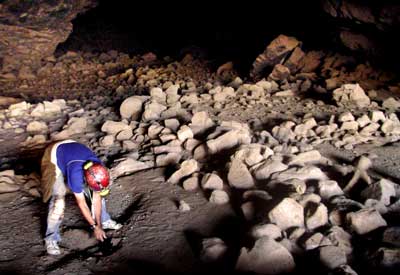 |
 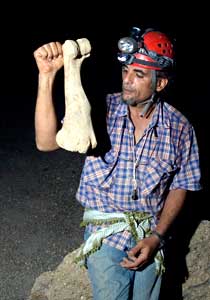 After lunch we all go over to the Wolf Passage. Mahmoud and the drivers go all the way to the far end of the cave and bring back a human skull, fragments of two more skulls which look like they’ve been used as bowls, a very thick bone and a springy curved stick made of very hard wood... LEFT: From left to right the ages of the three skull parts are: 150 years, 3410 years and 4040 years before present. RIGHT: This large bone which appears not to have come from a camel, is 2285 years old. All these items were found on the surface of the meter-thick dirt floor. Much older bones may be buried underneath. |
...I take pictures of the spectacular Wolf Passage entrance and find a small swift’s nest on the floor. Woven into it are many strands of green plastic that look like they’ve been unraveled from a feed sack or tarp.
|
At 7:00 Pm we exit the collapse and collapse. There’s a slight breeze and it feels quite pleasant as we sit around the fire under the slightly fuller moon. Since we’ve been on the move all day long, we’re all hungry and Hamadi decides to make his famous barbecue chicken. It’s so good that we all decide Hamadi should open a restaurant. “OK,” says Hamadi, “I will open a restaurant with Abu Adel… and Sa’ad will be the dishwasher.” That leads us to the subject of how each person has some special talent. “All except Sa’ad” says Hamadi, joking. These two guys have been pulling each other’s leg for all the years I’ve known them. LEFT: Sa'ad RIGHT: Hamadi |
I intervene: “No, no. Sa’ad has a special talent too,” I state, obviously with
Mahmoud’s help as translator.
“What could that be?” they ask.
“Why he’s the world’s greatest story teller,” I say, reminding them of how he
pulled the wool over my eyes exactly one month earlier when we found a wide mud
flat in the far north and he convinced me he used to play football there with
the Beni Hallal, a legendary tribe that hasn’t been seen for a thousand years.
We leave Umm Jirsan Cave System convinced that Saudi Arabia’s Harrat Khaybar is,
indeed, the most promising caving frontier in the Middle East and perhaps one of
the most important in the world.
(If you’d like to read a paper on what makes this lava field so interesting, see
“Prospects for Lava-cave Studies in Harrat Khaybar, Saudi Arabia” by John J.
Pint in Proceedings of the X, XI, and XII International Symposia on
Vulcanospeleology, edited by Ramón Espinasa and John Pint:
AMCS, Austin, 2008.
305 pages plus CD. Download the PDF file.)
John Pint
|
|